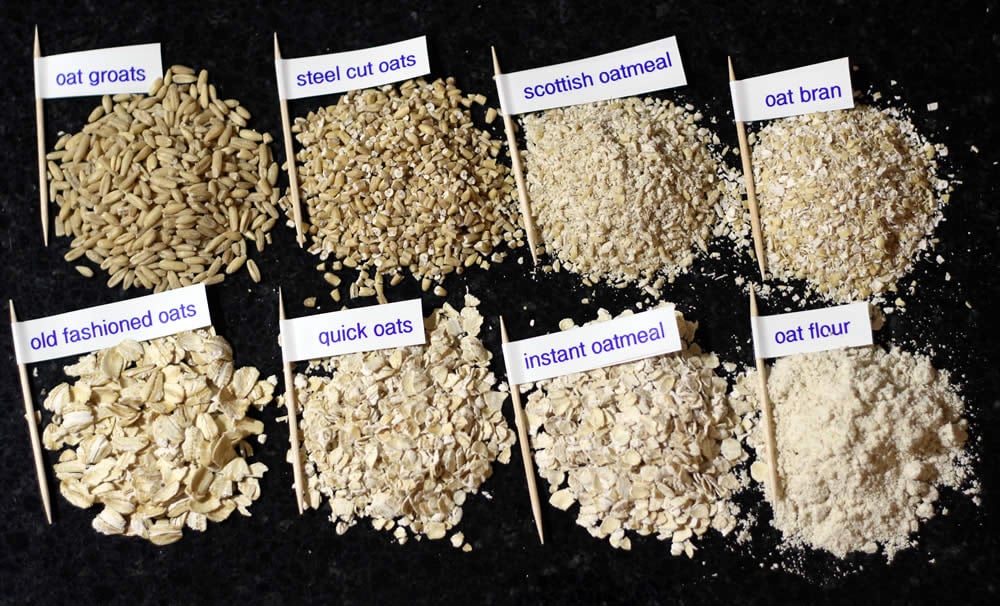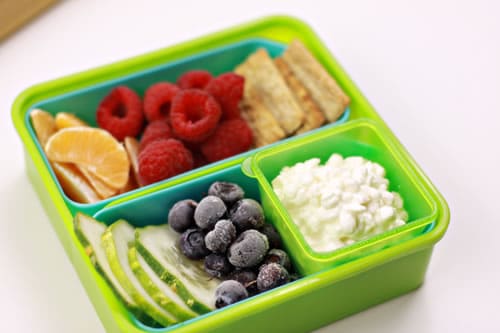The Types of Oatmeal
Last Updated October 14, 2017 · First Published October 5, 2012
Groats. It’s a funny word. Could be a grumpy goat or a healthy whole grain. Since this post is part of October Unprocessed and I’m a nutrition nerd, odds are it’s the latter. (Actually, I’m also an animal-loving nerd, so really, it’s a crap shoot.)
I’m sure you’ve heard that you should eat less processed foods. Heck, as a dietitian, I’ve been doling out that advice for ten years. But, it’s kind of a confusing concept. At the most basic level, any change intentionally made to a food before it winds up on our taste buds counts as processing. It can range from dehydrating fruits to hydrogenating fats and the different types of processing can be straightforward or complex. Unless you’re living sustainably and exclusively from your own grain field, vegetable garden, and fruit trees, the truth is that you’re probably consuming processed foods. Join the club.
What does processing really look like? Let’s take oats as a case in point. If you’re a visual learner, please consider the photo at the top of this post. See if you can tell the difference between the many piles of oaty goodness. (I’ll explain more about the piles in a minute…)
One of the most memorable quotes from the movie Super Size Me is this: “It is a matter of common knowledge that any processing that foods undergo serves to make them more harmful than unprocessed foods.” As a general rule, the more we mess with it, the worse it is for us. So why do we do it? Reasons for processing can be to improve taste, shorten preparation time, or increase shelf life, so it’s not all done with bad intentions.
Oats are a perfect example of a food available in the marketplace that’s gone through varying levels of mechanical processing. They’re also a picture-perfect example of a healthy food, as their heartiness seems to be especially satiating in our bellies and their fiber seems to lower cholesterol in our blood. (In a country where the two-thirds of us are overweight and the leading cause of death is heart disease, that’s no small feat.)
One of the most common reasons oats and other foods are processed in the first place is to reduce cooking time. Oat groats take 60 minutes to cook while instant oatmeal is ready in 60 seconds. Nutritionally speaking, all the options pictured are considered whole grains, but the closer you get to the groat end of the spectrum, the better (good advice for all areas of life, I think). If you’re not ready to dedicate an hour to your breakfast cereal, aim for the other oat options that are minimally processed. We use the brown rice setting on our rice cooker to make groats in the evening (while we watch Mythbusters or Wipeout or something else educational), and we’ve a got healthy breakfast for the whole week that can be reheated in the same time it takes to make the instant stuff. Check out my recipes for Cherry Maple Granola or Coconut Mango Barley Breakfast (just substitute cooked oat groats for the barley in this one) if you want to get a little grainy this month.
Here are the types of oats shown in the picture above:
Oat groats: as whole grainy as you can get where oats are concerned. Unadulterated. Only the inedible hull has been removed. Cooks in 50-60 minutes.
Steel cut oats: also called Irish oats or pinhead oats, these are just groats that have been cut into smaller pieces to speed cooking. Cook in 10-20 minutes.
Scottish oatmeal: another version of groats that have been broken into bits, only these are stone ground instead of being cut. Cooks in 10 minutes.
Oat bran: a high-fiber part of the oat that’s been removed and can be eaten separately. Oat bran can be prepared as its own hot cereal or simply sprinkled on your favorite bowl of breakfast to boost the nutrient content of every bite. Cooks in 2 minutes.
Old fashioned oats: groats that are steamed and then pressed flat. Increasing the surface area this way and partially cooking them helps you get breakfast to your mouth faster. Cooks in 5 minutes.
Quick oats: like old-fashioned oats, except rolled thinner and steamed longer. Cook in 1 minute.
Instant oatmeal: like quick oats, except rolled even thinner and steamed even longer. Cooks in 1 minute. (This is the only product on this list that has been processed in an additional way – it’s had stuff added to it before packaging. In the case of the “original” or plain flavor, pictured here, salt, color, vitamins and minerals have been mixed with the oat flakes. The popular flavored packets have all that, plus added sugar, which bumps up the calories.)
Oat flour: pulverized groats that can be used in baking, etc. This is still considered a whole grain because nothing was removed before the oats were ground into flour.
Remember, it’s all relative. It doesn’t have to be all whole grains all the time. If you’re currently eating quick oats, go one step to the left on the spectrum for October Unprocessed. Chances are you’ll be amazed and delighted by the change in texture and you’ll have yourself a new favorite breakfast. And if you go all the way to the groats, you’ll have a new favorite word.





















Tried groats for the first time this morning – love, love, love!!! It’s nice to have a crunchy oat cereal – haven’t had crunchy cereal in decades. Cooked a batch in Instant Pot yday, reheated a bowlful this morning, added flax and chia seeds, sea salt and raw spinach – yummm!!!
Thank you so much for sharing with us the great information
So If I was to take a piece of broccoli and chew it to a pulp would it be less healthy than swallowing the whole thing whole? I guess I don’t understand how cutting something in half or into bits can lower the nutritional value?
Hi Branden. I wouldn’t say it lowers the nutritional value, in terms of nutrient content like vitamins or minerals. But the more a food is cut, ground, or pounded before we put it in our mouth, the less work our body has to put in to digest and absorb it. The thinking is that the carbohydrate from instant oatmeal is more quickly available to the body than the carbohydrate from a whole oat groat, sort of like how orange juice is more rapidly absorbed than if we eat whole orange segments. This may not make a difference for some people, but it may play a role in how foods affect blood glucose levels after a meal. This could be important for people with diabetes or people who struggle with appetite control. Less processed foods seem to provide more satiation or satisfaction, which may delay eating and keep overall calorie intake… Read more »
Hi Kristine. Thanks so much for you article. I’m curious what the difference is (or how it affects the chemical breakdown) between a facility steaming and pressing oats into vs. someone boiling old fashioned oats at home. I’m a Health Coach so I’m always trying to deepen my understanding of nutrition. Thanks!
Hi Lauren. That’s a good question. It’s my understanding that the more work our digestive system has to do to get at the carbohydrate in whole grains, the better. Meaning, we get a slower bump in blood sugar if our body is doing the slower work of digesting a groat vs. the instant gratification of digesting instant oatmeal. I don’t think the steaming at a facility vs. the boiling at home would make a significant difference, but I’m not sure. I think it would be more a matter of how thinly they’re pressed. A thick cut oat would take more effort to digest than a very thin shard of instant oatmeal. Hope that makes sense.
Where do “Quaker Steel Cut Oats – Quick 3-minute” fall on the chart. It’s confusing since they are “Steel Cut Oats” however they cook in 3 minutes – instead of the 10-20 minutes you show for steel cut oats in your article. Are the Quaker Steel Cut Oats a good choice?
Thank you,
Gary
Hi Gary. That’s a good question. Looks like Quaker is mixing up the program by adding even more oat products to the shelves! Yes, I think they’re a good choice. The ingredient list shows only “whole grain steel cut oats”. Their “3-minute” claim applies only if you cook them in the microwave, which will always be shorter than stove top cooking time. However, their stove top directions say they only take 5 minutes. So my best guess is that they’ve been pre-cooked or pre-steamed to shorten cooking time.
Which type of oatmeal is best in a baking recipe: quick or old fashioned oatmeal ? Some of my cookbooks are from the 30’s, 40’s, 60’s, & newer so just wanted to dbl check on your thoughts.
Hi Kate. That’s a good question, though I’m not sure how helpful my answer will be. I usually just use whichever of the two I have on hand, and I haven’t really noticed a big difference in the final product. So I think they’re nearly interchangeable. It depends of course on the recipe itself, how long it cooks (if it cooks at all), etc. Old fashioned would likely give a little more texture, like in an oatmeal cookie or a muesli. Quick oats would likely offer a little less structure but more of a thickening property. I’d be interested in comments from other folks who’ve tested this out in their own kitchen. I did some very limited research online and it looks like quick oats were introduced in the 1920s, so it’s possible your older recipes would work with those or with the more traditional old fashioned oats.
Steel cut should have a different cooked texture than any of the rolled (flat) oats. It’s going to be quite a bit more chewy, depending on how long you cook it,
Are steel cut oats suppose to have a different texture than old fashion oats after cooking? Trying to determine if I didn’t cook them longer or not.
Hi there…came across this post by a search on google for some oatsy images. And this was the best to show the different types. Hope you dont mind me sharing this picture of yours on my fb page.
Hi Sona – Happy for you to share, but please link to the post instead of sharing just the picture. 🙂 Thanks!
Cook grains using Pressure cooker. It takes maximum of 5 minutes only. That is the way I cook my Pearl Barley for my breakfast. No need to soak barley overnight if you use pressure cooker for cooking.